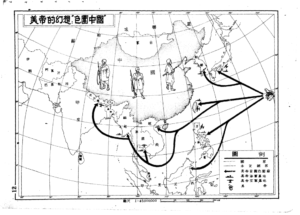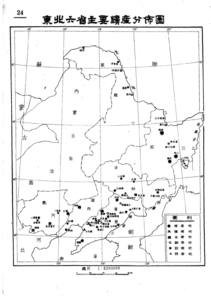Resisting America and Aiding Korea in Early 1950s Exhibitions - the case of the 抗美援朝运动中的东北与朝鲜图集 (1951)
Resisting America and Aiding Korea in Early 1950s Exhibitions - the case of the 抗美援朝运动中的东北与朝鲜图集 (1951)
Shortly after the founding of the People’s Republic the Chinese Communist Party soon faced existential problems caused by geopolitical shifts in the East Asian region. The outbreak of the Korean War in June 1950 — since then largely seen as a proxy war — was not only seen as a war concerning the rivaling forces on the Korean peninsula, but one where the great powers tested their strength, with certainly Korea and probably China becoming the victim of the conflict. When the new government in Beijing engaged in propagating its ideology on a nation-wide scale in 1949 it was not only the fight for hygiene and the dissemination of technological and technical knowledge that was communicated, but also knowledge on the global situation that should make the Chinese people vigilant. Patriotism at that time was considered to be founded on class politics and the Cold War mentality that emphasized the confrontation between capitalist and socialist camps.
In December 1950, the People’s Central Science Hall in Beijing mounted an exhibition of “The Northeast and Korea”, using (the rhetoric of) science to naturalize the political and military campaign of “resisting America and aiding Korea.” This exhibition was a major one, drawing an audience of up to 8,000 per day. Like many lectures given by renowned scientists in the hall between 1950 and 1951, most of its visual and textual materials were published in book form to extend their influence beyond the limits of time and space of the exhibition per se. Combined with a descriptive report on the exhibition, the materials in this book allow us to reconstruct the exhibition as an imagined spectator.
The exhibition consists of three parts. The first part argues, with maps and statistic figures, that the attempt of the “American imperialist” to build its hegemony over the world is doomed. The second part employs artifacts – specimens, models, replicas, etc. – to demonstrate the strategic importance of the Northeast for the economic development of the new China. The last part introduces Korea as a strategic partner and ideological comrade of China and accuses the “American imperialist” of invading Korea. As spectator, we first encounter a large globe of one meter in diameter at the entrance of the exhibition, which visualizes the distribution of the two political camps. Following the Soviet Union, the only socialist country, are the “new democratic countries” – China, Mongolia, Korea, and East Europe. Peoples rising up against imperialism, indicated by little figures holding guns in Malaysia, Indonesia, and Greece, etc., also show the growing influence of the socialist camp. The rest of the world are the “followers” and “slaves” in the “imperialist camp led by the US.” Despite the visual message, however, the caption predicts that the “peaceful and democratic camp led by the Soviet Union” is becoming stronger everyday while that led by the American imperialists is declining. This prediction is backed up by a map and a table including undefined “left-leaning” people and those “advocating peace and democracy” – which more or less covering the whole world – as power against the “American imperialist.” Having predicted the doomed fate of the “imperialist camp,” the exhibition goes on showing “The Futile Dream of the American Imperialist to Besiege China.”
The “American imperialist,” according to the map legend, is represented by a caricature of the head of Douglas MacArthur (1880-1964), who was leading the United Nations Command at the time. From this caricatured head shoot out three bold arrows over the Pacific, indicating the major directions that the “American imperialist” will go to besiege China. One of them is directed to Japan which furcates towards Korea. Others aim at American navy and air force bases in South and other parts of East Asia. Mainland China, the object of the alleged besiege, is defined not just by its borders and territory, but also by the three soldier figures vigilantly facing three directions – except for that of Mongolia and the Soviet Union. The one facing Korea levels up his gun and appears more on alert. The apparent objectivity of the map – or the plan of attack – is undermined by its legend which constantly uses the derogatory “American imperialist” (Meidi 美帝) to refer to the US and a caricature to refer to the United Nations Command. Therefore, this illustration in fact intends to kindle patriotism by arousing emotion against the US. The assumption that such unsubtle, thinly-veiled hostility imposed on the map would work with the spectator shows that the exhibition was expecting spectators of relatively low education.
Assured that the “American imperialist” is doomed, the spectator enters the second part of the exhibition, which shows the strategic importance of the six provinces of the Northeast for the new China. Possessing rich natural resources and the most developed transportation system and industry, the textual explanation argues, this area is key to the economic development of China. This point is demonstrated by several maps illustrating its agriculture, forestry, industry, transportation infrastructure as well as the area’s ability of accommodating immigrants. They are, in turn, supported by a selection of specimens of agricultural and textile products, furs, wood, minerals, replicas of blast furnace from Anshan Iron and Steel Works and a model of Fengman hydroelectric power station (a project starting by Manchukuo since 1937). This part intends to convince the spectator of the current productivity and future potential of the Northeast, which should lead them to conclude that the Northeast has to be protected in order to build a wealthy and strong new China.
The third part of the exhibition, in contrast to the first part which intends to arouse hatred of the US, attempts to cultivate in the spectator the feeling of camaraderie towards the Korean people. Photos are presented to show the beautiful landscape of Korea, the sufferings of the Korean people as well as the “waking-up” American prisoners of war protesting the invasion of Korea. The maps are used to argue that Korea can be used as the springboard by the US to grab the Northeast of China. If the spectator follows the three parts of the exhibition as intended by its designer, then the knowledge and emotion s/he develops would correspond and be reinforced by the slogans written in six lines of big characters on the wall of the exit: “To liberate Korea/ To safeguard our Northeast/ To realize the independence of China/ To achieve the victory of the peaceful and democratic camp/ We have no choice/ But resolutely resist America and aid Korea” [1].
With the benefit of hindsight, we know that the “American imperialist’s” invasion of Korea was not true. Yet before we dismiss the exhibition as a piece of propaganda, it may be more interesting to ask why this exhibition was held in the People’s Central Science Hall in the first place, that is, how did this exhibition argue for the necessity, if not inevitability, of the campaign of “resisting America and aiding Korea” in the framework of science dissemination? In fact, the exhibition was part of the on-going ideological campaigns of instilling patriotism, socialism, and historical materialism into the minds of the population.
In the short preface of the book of the exhibition materials the editors Chen Li and Jin Ruishen said that the book, whose main contents are pictures, was devoted to readers of higher primary school education, which means those with about four to five years of schooling. It is, therefore, reasonable to assume that this audience was also the prospective spectator. For this audience, the science hall plays an authoritative role of education, which determines what counts as scientific knowledge. In this exhibition, the ideological agenda and political mobilization are naturalized as knowledge of geography. By “drawing on science as a powerful publicly accessible and universally valid rhetorical resource,” [2] this exhibition claims the truthfulness of its contents, a claim in turn cemented by its location in the science hall. The convincing argument in it was the constant — even if implicit — referral to the authentic character of the maps and photos, i.e. by claiming their objectivity as geographical knowledge and truthful record of facts. In addition, artifacts such as specimens, models, and replicas are presented as “other tangible ‚evidence’” [3] to increase the power of persuasion. As any other exhibitions, this exhibition uses these visual and tangible evidence to present a way of ordering the world: seeing the world and making sense of it. Dividing the whole globe is divided into two camps led by two superpowers, China allies itself with the good – progressive and peace-loving – side of the Soviet Union. The geography of the Northeast, on the other hand, is understood in the sense of economic profitability and development for the newly founded China. This ordering of the world not only was conveyed to the spectator as “truthful” scientific knowledge, but also intended to appeal to their sentiment and emotion. It lifts them out of their everyday life and inviting them “to think like a statesman, to feel responsible for the entire country …, and, more importantly, was expected to do so” (Schmid 2006: 335). This sense of responsibility would shape a public identity – hence patriotism, which would also be reinforced by hatred that may be aroused by the emotional use of the derogatory word “the American imperialist” and McArthur’s caricature to refer to the US on the map.
Sources
Chen Li 陈励, Jin Ruishen 金瑞莘 (1951): Kangmei yuanchao yundong zhong de dongbei yu chaoxian tuji 抗美援朝运动中的东北与朝鲜图集. Shanghai: Zhonghua shuju.
Jin Ruishen 金瑞莘 (1951): “Beijing shi juban ’Dongbei yu chaoxian’ zhanlanhui”, in: Kexue pubji gongzuo , p. 11-12.
Macdonald, Sharon (ed.) (1998): The Politics of Display: Museums, Science, Culture. London and New York: Routledge.
Schmid, Sonja (2006): Celebrating Tomorrow Today: The Peaceful Atom on Display in the Soviet Union, in: Social Studies of Science, Vol. 36, No. 3, pp. 331-365.
Rui Kunze

